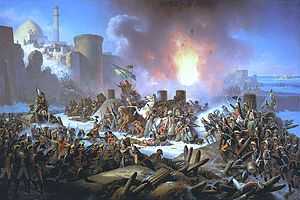Russo-Turkish War (1787–92)
| Russo-Turkish War (1787–1792) | |||||||||
|---|---|---|---|---|---|---|---|---|---|
 Siege of Ochakov 1788, by January Suchodolski | |||||||||
| |||||||||
| Belligerents | |||||||||
|
|
| ||||||||
| Commanders and leaders | |||||||||
|
|
| ||||||||
| Strength | |||||||||
| 100,000 | ? | ||||||||
The Russo–Turkish War of 1787–1792 involved a futile attempt by the Ottoman Empire to regain lands lost to Russia in the course of the previous Russo-Turkish War (1768–74). It took place concomitantly with the Austro-Turkish War of 1787–91.
In the spring of 1787, Catherine II of Russia made a triumphal procession through New Russia and the annexed Crimea in company with her ally, Holy Roman Emperor Joseph II. These events, the rumors about Catherine's Greek Plan and the friction caused by the mutual complaints of infringements of the Treaty of Küçük Kaynarca, which had ended the previous war, stirred up public opinion in Constantinople, while the British and French ambassadors lent their unconditional support to the Ottoman war party.
In 1788, war was declared and the Russian ambassador to the Ottomans, Yakov Bulgakov, was thrown into prison, but Ottoman preparations were inadequate and the moment was ill-chosen, now that Russia and Austria were in alliance, a fact of which the Ottomans became aware only when the horsetails were planted for the campaign. The Ottomans drove back the Austrians from Mehadia and overran the Banat (1789); but in Moldavia, Field Marshal Pyotr Rumyantsev captured Iași and Khotyn. After a long winter siege, Ochakov fell to Prince Grigory Potemkin. This news affected the Sultan, Abdul Hamid I, so deeply as to cause his death.
Accordingly, the Treaty of Jassy was signed with Russia on 9 January 1792, recognizing Russia's 1783 annexation of the Crimean Khanate. Yedisan (Odessa and Ochakov) was also ceded to Russia, and the Dniester was made the frontier in Europe, while the Asiatic frontier—the Kuban River—remained unchanged. The Ottoman generals were incompetent and the army mutinous; expeditions for the relief of Bender and Akkerman failed, Belgrade was taken by Laudon of Austria, the supposedly impenetrable fortress of Izmail was captured by Suvorov by surprise attacks using combined infantry and artillery, Ushakov shattered the Ottoman fleet at Fidonisi, Tendra, Kerch Strait, and Cape Kaliakra, and the fall of Anapa to Ivan Gudovich in 1791 completed the series of Ottoman disasters.
The young Sultan Selim III was anxious to restore his country's prestige by a victory before making peace, but the condition of his troops made this hope impossible. On 31 January 1790, Prussia signed an offensive treaty with the Ottoman Empire, but instead of directly joining the war with the Turkish side, Prussia pressed Sweden into war against Russia despite opposition from military officers stationed in Finland. Russia in turn pressed Denmark–Norway into war against Sweden.
References
- The detailed plan of movements of the allied Russian imperial and Austrian armies in Moldova and Bessarabia 1787–1791.
-
 This article incorporates text from a publication now in the public domain: Chisholm, Hugh, ed. (1911). Encyclopædia Britannica (11th ed.). Cambridge University Press.
This article incorporates text from a publication now in the public domain: Chisholm, Hugh, ed. (1911). Encyclopædia Britannica (11th ed.). Cambridge University Press.
| Wikimedia Commons has media related to Russo-Turkish War (1787–1792). |